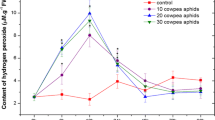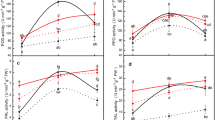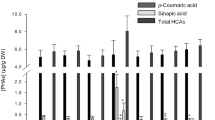Abstract
The perception of aphid infestation induces highly coordinated and sequential defensive reactions in plants at the cellular and molecular levels. The aim of the study was to explore kinetics of induced antioxidative defence responses in leaf cells of Pisum sativum L.cv. Cysterski upon infestation of the pea aphid Acyrthosiphon pisum at varying population sizes, including accumulation of flavonoids, changes of carbon metabolism, and expression of nuclear genes involved in sugar transport. Within the first 96 h, after A. pisum infestation, flavonoid accumulation and increased peroxidase activity were observed in leaves. The level of pisatin increased after 48 h of infestation and reached a maximum at 96 h. At this time point, a higher concentration of flavonols was observed in the infested tissue than in the control. Additionally, strong post-infestation accumulation of chalcone synthase (CHS) and isoflavone synthase (IFS) transcription products was also found. The levels of sucrose and fructose in 24-h leaves infested by 10, 20, and 30 aphids were significantly lower than in the control. Moreover, in leaves infested by 30 aphids, the reduced sucrose level observed up to 48 h was accompanied by a considerable increase in the expression level of the PsSUT1 gene encoding the sucrose transporter. In conclusion, A. pisum infestation on pea leads to stimulation of metabolic pathways associated with defence.










Similar content being viewed by others
Abbreviations
- ABTS+ :
-
The 2,2'-azino-bis-(3-ethylbenzthiazoline-6-sulphonic acid) cation
- CHS:
-
Chalcone synthase
- DPBA:
-
Diphenylboric acid 2-aminoethyl ester
- G:
-
Gram
- Hpi:
-
Hours post infestation
- IFS:
-
Isoflavone synthase
- LC/UV/ESI/MS/MS:
-
Liquid chromatography/ultraviolet detection/electrospray/mass spectrometry (tandem mass spectrometry)
- POX:
-
Peroxidase
- ROS:
-
Reactive oxygen species
- SUT1:
-
Sucrose transporter
- SUF1, SUF4:
-
Sucrose facilitators
- SWEETs:
-
Sugar efflux carriers
- TAC:
-
Total antioxidant capacity
References
Akerström B, Maghzal GJ, Winterbourn CC, Kettle AJ (2007) The lipocalin 1-microglobulin has radical scavenging activity. J Biol Chem 282(43):31493–31503
Allison SD, Schultz JC (2004) Differential activity of peroxidase isozymes in response to wounding, gypsy moth, and plant hormones in northern red oak (Quercus rubra L.). J Chem Ecol 30(7):1363–137
Ateyyat M, Abu-Romman S, Abu-Darwish M, Ghabeish I (2012) Impact of flavonoids against woolly apple aphid, Eriosoma lanigerum (Hausmann) and its sole parasitoid, Aphelinus mali (Hald.). J Agric Sci 4(2):227–236
Berthier A, Desclos M, Amiard V, Morvan-Bertrand A, Demmig-Adams B, Adams WW 3rd, Turgeon R, Prud'homme MP, Noiraud-Romy N (2009) Activation of sucrose transport in defoliated Lolium perenne L.: an example of apoplastic phloem loading plasticity. Plant Cell Physiol 50(7):1329–1344
Bitterlich M, Krügel U, Boldt-Burisch K, Franken P, Kühn C (2014) The sucrose transporter SlSUT2 from tomato interacts with brassinosteroid functioning and affects arbuscular mycorrhiza formation. Plant J 78(5):877–89
Bolouri-Moghaddam MR, Le Roy K, Xiang L, Rolland F, Van den Ende W (2010) Sugar signalling and antioxidant network connections in plant cells. FEBS J 277:2022–2037
Bourdon E, Blache D (2001) The importance of proteins in defense against oxidation. Antioxid Redox Signal 3(2):293–311
Bradford M (1976) A rapid and sensitive method for the quantification of microgram quantities of protein utilizing the principle of protein-dye binding. Anal Biochem 72:248–254
Chen S, Li XQ, Zhao A, Wang L, Li X, Shi Q, Chen M, Guo J, Zhang J, Qi D, Liu G (2009) Genes and pathways induced in early response to defoliation in rice seedlings. Curr Issues Mol Biol 11(2):81–100
Chen LQ, Qu XQ, Hou BH, Sosso D, Osorio S, Fernie AR, Frommer WB (2012) Sucrose efflux mediated by SWEET proteins as a key step for phloem transport. Science 335:207–211
Chen LQ, Lin IW, Qu XQ, Sosso D, McFarlanec HE, Londoñoa A, Samuelsc AL, Frommer WB (2015) A cascade of sequentially expressed sucrose transporters in the seed coat and endosperm provides nutrition for the Arabidopsis embryo. Plant Cell 27(3):607–619
Chincinska IA, Liesche J, Krugel U, Michalska J, Geigenberger P, Grimm B, Kühn C (2008) The sucrose transporter StSUT4 from Solanum tuberosum affects flowering, tuberization and shade avoidance response. Plant Physiol 146:515–528
Christensen JH, Bauw G, Welinder KG, Van Montagu M, Boerjan W (1998) Purification and characterization of peroxidases correlated with lignification in poplar xylem. Plant Physiol 118(1):125–135
Dao TT, Linthorst HJ, Verpoorte R (2011) Chalcone synthase and its functions in plant resistance. Phytochem Rev 10(3):397–412
Dibley K (2012) The functional characterisation of novel sucrose transporters. Dissertation. The University of Newcastle
Doidy J, Grace E, Kühn C, Simon-Plas F, Casieri L, Wipf D (2012) Sugar transporters in plants and in their interactions with fungi. Trends Plant Sci 17(7):413–422
Douglas AE (2006) Phloem-sap feeding by animals: problems and solutions. J Exp Bot 57(4):747–754
Dubey NK, Idris A, Verma AK, Chandrashekar K, Pandey KD (2013) Expression pattern of sucrose transporters in Arabidopsis thaliana during aphid (Myzus persiace) infestation. Am J Plant Sci 4:47–51
Endler A, Meyer S, Schelbert S, Schneider T, Weschke W, Peters SW, Keller F, Baginsky S, Martinoia E, Schmidt UG (2006) Identification of a vacuolar sucrose transporter in Barley and Arabidopsis mesophyll cells by a tonoplast proteomic approach. Plant Physiol 141:196–207
Ferrieri AP, Arce CC, Machado RA, Meza-Canales ID, Lima E, Baldwin IT, Erb M (2015) A Nicotiana attenuata cell wall invertase inhibitor (NaCWII) reduces growth and increases secondary metabolite biosynthesis in herbivore-attacked plants. New Phytol. doi:10.1111/nph.13475
Floryszak-Wieczorek J, Arasimowicz M, Milczarek G, Jeleń H, Jackowiak H (2007) Only an early nitric oxide burst and the following wave of secondary nitric oxide generation enhanced effective defence responses of pelargonium to a necrotrophic pathogen. New Phytol 175:718–730
Formela M, Samardakiewicz S, Marczak Ł, Nowak W, Narożna D, Bednarski W, Kasprowicz-Maluśki A, Morkunas I (2014) Effects of endogenous signals and Fusarium oxysporum on the mechanism regulating genistein synthesis and accumulation in yellow lupine and their impact on plant cell cytoskeleton. Molecules 19(9):13392–13421
Fotopoulos V, Gilbert MJ, Pittman JK, Marvier AC, Buchanan AJ, Sauer N, Hall JL, Williams LE (2003) The monosaccharide transporter gene, AtSTP4, and the cell-wall invertase, Atbetafruct1, are induced in Arabidopsis during infection with the fungal biotroph Erysiphe cichoracearum. Plant Physiol 132(2):821–829
Gould KS, Lister C (2006) Flavonoid functions in plants. In: Andersen ØM, Markham KR (eds) Flavonoids: chemistry, biochemistry and applications. CRC Press, London, New York, Boca Raton, pp 397–441
Harborne JB, Williams CA (2000) Advances in flavonoid research since 1992. Phytochemistry 55(6):481–504
Hernández I, Alegre L, Van Breusegem F, Munné-Bosch S (2009) How relevant are flavonoids as antioxidants in plants? Trends Plant Sci 14:125–132
Hodge S, Ward JL, Beale MH, Bennett M, Mansfield JW, Powell G (2013) Aphid-induced accumulation of trehalose in Arabidopsis thaliana is systemic and dependent upon aphid density. Planta 237:1057–1064
Jeandet P, Clément C, Courot E, Cordelier S (2013) Modulation of phytoalexin biosynthesis in engineered plants for disease resistance. Int J Mol Sci 14(7):14136–14170
Jeandet P, Hébrard C, Deville MA, Cordelier S, Dorey S, Aziz A, Crouzet J (2014) Deciphering the role of phytoalexins in plant-microorganism interactions and human health. Molecules 19(11):18033–18056
Kempema LA, Cui X, Holzer FM, Walling LL (2007) Arabidopsis transcriptome changes in response to phloem-feeding silver leaf whitefly nymphs. Similarities and distinctions in responses to aphids. Plant Physiol 143(2):849–865
Koch K (2004) Sucrose metabolism: regulatory mechanisms and pivotal roles in sugar sensing and plant development. Curr Opin Plant Biol 7:235–246
Kotkar HM, Mendki PS, Sadan SV, Jha SR, Upasani SM, Maheshwari VL (2002) Antimicrobial and pesticidial activity of partially purified flavonoids of Annona squamos. Pest Manag Sci 58(1):33–37
Kühn C (2010) Sucrose transporters in plant development. In: Geisler M, Venema K (ed) Signaling and Communication in Plants: Transporters and pumps in plant signaling, Springer Verlag Heidelberg, pp. 225-251
Kühn C, Grof CP (2010) Sucrose transporters of higher plants. Curr Opin Plant Biol 13(3):288–298
Kühn C, Hajirezaei MR, Fernie AR, Roessner-Tunali U, Czechowski T, Hirner B, Frommer WB (2003) The sucrose transporter StSUT1 localizes to sieve elements in potato tuber phloem and influences tuber physiology and development. Plant Physiol 131:102–113
Kuśnierczyk A, Winge P, Jørstad TS, Trończyska J, Rossiter JT, Bones AM (2008) Towards global understanding of plant defense against aphids—timing and dynamics of early Arabidopsis defense responses to cabbage aphid (Brevicoryne brassicae) attack. Plant Cell Environ 31(8):1097–1115
Lammens W, Le Roy K, Van Laere A, Rabijns A, Van den Ende W (2008) Crystal structures of Arabidopsis thaliana cell-wall invertase mutants in complex with sucrose. J Mol Biol 377(2):378–385
Lattanzio V, Arpaia S, Cardinali A, di Venere D, Linsalata V (2000) Role of endogenous flavonoids in resistance mechanism of Vigna to aphids. J Agric Food Chem 48:5316–5320
Lemoine R, La Camera S, Atanassova R, Dédaldéchamp F, Allario T, Portau N, Bonnemain J-L, Laloi M, Coutos-Thiévenot P, Maurousset L, Faucher M, Girousse C, Lemonnier P, Parrilla J, Durand M (2013) Source-to-sink transport of sugar and regulation by environmental factors. Front Plant Sci 4(272):1–21
Lev-Yadun S, Gould KS (2009) Role of anthocyanins in plant defense. In: Gould KS, Davies KM, Winefield C (ed) Life's colorful solutions: the biosynthesis, functions and applications of anthocyanins, Springer-Verlag Berlin, pp. 21–48
Livak KJ, Schmittgen TD (2001) Analysis of relative gene expression data using real-time quantitative PCR and the 2− ΔΔC T method. Methods 25(4):402–408
Mai VC, Bednarski W, Borowiak-Sobkowiak B, Wilkaniec B, Samardakiewicz S, Morkunas I (2013) Oxidative stress in pea seedling leaves in response to Acyrthosiphon pisum infestation. Phytochemistry 93:49–62
Mai VC, Drzewiecka K, Jeleń H, Narożna D, Rucińska-Sobkowiak R, Kęsy J, Floryszak-Wieczorek J, Gabryś B, Morkunas I (2014) Differential induction of Pisum sativum defense signaling molecules in response to pea aphid infestation. Plant Sci 221–222:1–12
Moran PJ, Thompson GA (2001) Molecular responses to aphid feeding in Arabidopsis in relation to plant defense pathways. Plant Physiol 125:1074–1085
Moran PJ, Cheng Y, Cassell JL, Thompson GA (2002) Gene expression profiling of Arabidopsis thaliana in compatible plant–aphid interactions. Arch Insect Biochem Physiol 51:182–203
Morkunas I, Gmerek J (2007) The possible involvement of peroxidase in defence of yellow lupine embryo axes against Fusarium oxysporum. J Plant Physiol 164(2):185–194
Morkunas I, Ratajczak L (2014) The role of sugar signaling in plant defense responses against fungal pathogens. Acta Physiol Plant 36(7):1607–1619
Morkunas I, Marczak Ł, Stachowiak J, Stobiecki M (2005) Sucrose-stimulated accumulation of isoflavonoids as a defense response of lupine to Fusarium oxysporum. Plant Physiol Biochem 43:363–373
Morkunas I, Kozłowska M, Ratajczak L, Marczak Ł (2007) Role of sucrose in the development of Fusarium wilt in lupine embryo axes. Physiol Mol Plant Pathol 70:25–37
Morkunas I, Stobiecki M, Marczak Ł, Stachowiak J, Narożna D, Remlein-Starosta D (2010) Changes in carbohydrate and isoflavonoid metabolism in yellow lupine in response to infection by Fusarium oxysporum during the stages of seed germination and early seedling growth. Physiol Mol Plant Pathol 75:46–55
Morkunas I, Mai VC, Gabryś B (2011a) Phytohormonal signaling in plant responses to aphid feeding. Acta Physiol Plant 33(6):2057–2073
Morkunas I, Narożna D, Nowak W, Samardakiewicz S, Remlein-Starosta D (2011b) Cross-talk interactions of sucrose and Fusarium oxysporum in the phenylpropanoid pathway and the accumulation and localization of flavonoids in embryo axes of yellow lupine. J Plant Physiol 168:424–433
Morkunas I, Formela M, Floryszak-Wieczorek J, Marczak Ł, Narożna D, Nowak W, Bednarski W (2013) Cross-talk interactions of exogenous nitric oxide and sucrose modulates phenylpropanoid metabolism in yellow lupine embryo axes infected with Fusarium oxysporum. Plant Sci 211:102–121
Mutti NS, Louis J, Pappan L, Pappan K, Begum K, Chen M-S, Park Y, Dittmer N, Marshall J, Reese JC, Reeck GR (2008) A protein from the salivary glands of the pea aphid, Acyrthosiphon pisum, is essential in feeding on a host plant. Proc Natl Acad Sci U S A 105(29):9965–9969
Payyavula RS, Tay KHC, Tsai C-J, Harding SA (2011) The sucrose transporter family in Populus: the importance of a tonoplast PtaSUT4 to biomass and carbon partitioning. Plant J 65:757–770w
Peer WA, Murphy AS (2006) Flavonoid as signal molecules: targets of flavonoids action. In: Grotewold E (ed) The science of flavonoids. Springer, Berlin, pp 239–268
Pourcel L, Routaboul JM, Cheynier V, Lepiniec L, Debeaujon I (2007) Flavonoid oxidation in plants: from biochemical properties to physiological functions. Trends Plant Sci 12(1):29–36
Price DR, Gatehouse JA (2014) Genome-wide annotation and functional identification of aphid GLUT-like sugar transporters. BMC Genomics 15:647
Proels RK, Huckelhoven R (2014) Cell-wall invertases, key enzymes in the modulation of plant metabolism during defence responses. Mol Plant Pathol 15(8):858–64
Quiroga M, Guerrero C, Botella MA, Barceló A, Amaya I, Medina MI, Alonso FJ, de Forchetti SM, Tigier H, Valpuesta V (2000) A tomato peroxidase involved in the synthesis of lignin and suberin. Plant Physiol 122(4):1119–1128
Reinders A, Sivitz AB, Starker CG, Gantt JS, Ward JM (2008) Functional analysis of LjSUT4, a vacuolar sucrose transporter from Lotus japonicus. Plant Mol Biol 68:289–299
Reinders A, Sivitz A, Ward J (2012) Evolution of plant sucrose uptake transporters. Front Plant Sci 3:1–12
Rolland F, Baena-Gonzalez E, Sheen J (2006) Sugar sensing and signaling in plants: conserved and novel mechanisms. Annu Rev Plant Biol 57:675–709
Salunke BK, Kotkar HM, Mendki PS, Upasani SM, Maheshwari VL (2005) Efficacy of flavonoids in controlling Callosobruchus chinensis (L.) (Coleoptera: Bruchidae), a post-harvest pest of grain legumes. Crop Prot 24(10):888–893
Sauer N (2007) Molecular physiology of higher plant sucrose transporters. FEBS Lett 581(12):2309–2317
Schaarschmidt S, Roitsch T, Hause B (2006) Arbuscular mycorrhiza induces gene expression of the apoplastic invertase LIN6 in tomato (Lycopersicon esculentum) roots. J Exp Bot 57(15):4015–23
Scheidt HA, Pampel A, Nissler L, Gebhardt R, Huster D (2004) Investigation of the membrane localization and distribution of flavonoids by high-resolution magic angle spinning NMR spectroscopy. Biochim Biophys Acta 1663(1-2):97–107
Sherson SM, Alford HL, Forbes SM, Wallace G, Smith SM (2003) Roles of cell-wall invertases and monosaccharide transporters in the growth and development of Arabidopsis. J Exp Bot 54(382):525–531
Shiratake K (2007) Genetics of sucrose transporter in plants. Genes, Genomes and Genomics Global Science Books 1(1):73-80
Simmonds MSJ (2003) Flavonoid–insect interactions: recent advances in our knowledge. Phytochemistry 6:21–30
Simmonds MSJ, Stevenson PC (2001) Effects of isoflavonoids from Cicer on larvae of Helicoverpa armigera. J Chem Ecol 27(5):965–977
Singh V, Louis J, Ayre BG, Reese JC, Shah J (2011) TREHALOSE PHOSPHATE SYNTHASE11-dependent trehalose metabolism promotes Arabidopsis thaliana defense against the phloem-feeding insect Myzus persicae. Plant J 67(1):94–104
Sivitz AB, Reinders A, Johnson ME, Krentz AD, Grof CPL, Perroux JM, Ward JM (2007) Arabidopsis sucrose transporter AtSUC9. High affinity transport activity, intragenic control of expression and early-flowering mutant phenotype. Plant Physiol 143:188–198
Smith CM, Chuang WP (2014) Plant resistance to aphid feeding: behavioral, physiological, genetic and molecular cues regulate aphid host selection and feeding. Pest Manag Sci 70(4):528–540
Solfanelli C, Poggi A, Loreti E, Alpi A, Perata P (2006) Sucrose-specific induction of the anthocyanin biosynthetic pathway in Arabidopsis. Plant Physiol 140:637–646
Stobiecki M, Wojtaszek P, Gulewicz K (1997) Application of solid phase extraction for profiling of quinolisidine alkaloids and phenolic compounds in Lupinus albus. Phytochem Anal 8:153–158
Tjallingi WF (2006) Salivary secretions by aphids interacting with proteins of phloem wound responses. J Exp Bot 57(4):739–745
Upasani SM, Kotkar HM, Mendki PS, Maheshwari VL (2003) Partial characterization and insecticidal properties of Ricinus communis L. foliage flavonoids. Pest Manag Sci 59(12):1349–1354
Van Bel AJE, Hess PH (2008) Hexoses as phloem transport sugars: the end of a dogma? J Exp Bot 59(2):261–272
Van den Ende W (2013) Multifunctional fructans and raffinose family oligosaccharides. Front Plant Sci 4(247):1–11
Van Loon JJA, Wang CZ, Nielsen JK, Gols R, Qiu YT (2002) Flavonoids from cabbage are feeding stimulants for diamondback moth larvae additional to glucosinolates: chemoreception and behavior. Entomol Exp App 104:27–34
Voelckel C, Weisser WW, Baldwin IT (2004) An analysis of plant–aphid interactions by different microarray hybridization strategies. Mol Ecol 13:3187–3195
Wahl R, Wippel K, Goos S, Kämper J, Sauer N (2010) A novel high-affinity sucrose transporter is required for virulence of the plant pathogen Ustilago maydis. PLoS Biol 8(2):e1000303
Weschke W, Panitz R, Sauer N, Wang Q, Neubohn B, Wobus U (2000) Sucrose transport into barley seeds: molecular characterization of two transporters and implications for seed development and starch accumulation. Plant J 21:455–467
Wimmers LE, Turgeon R (1991) Transfer cells and solute uptake in minor veins of Pisum sativum leaves. Planta 186:2–12
Zhou Y, Qu H, Dibley KE, Offler CE, Patrick JW (2007) A suite of sucrose transporters expressed in coats of developing legume seeds includes novel pH-independent facilitators. Plant J 49(4):750–64
Acknowledgments
The study was supported by the Polish National Science Centre (NCN, grant no. 2011/01/B/NZ9/00074)
Conflict of interest
The authors declare that they have no competing interests.
Author information
Authors and Affiliations
Corresponding author
Additional information
Handling Editor: Néstor Carrillo
Rights and permissions
About this article
Cite this article
Morkunas, I., Woźniak, A., Formela, M. et al. Pea aphid infestation induces changes in flavonoids, antioxidative defence, soluble sugars and sugar transporter expression in leaves of pea seedlings. Protoplasma 253, 1063–1079 (2016). https://doi.org/10.1007/s00709-015-0865-7
Received:
Accepted:
Published:
Issue Date:
DOI: https://doi.org/10.1007/s00709-015-0865-7




